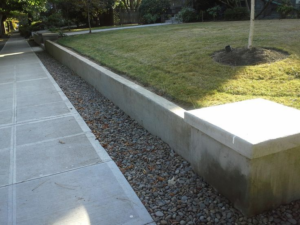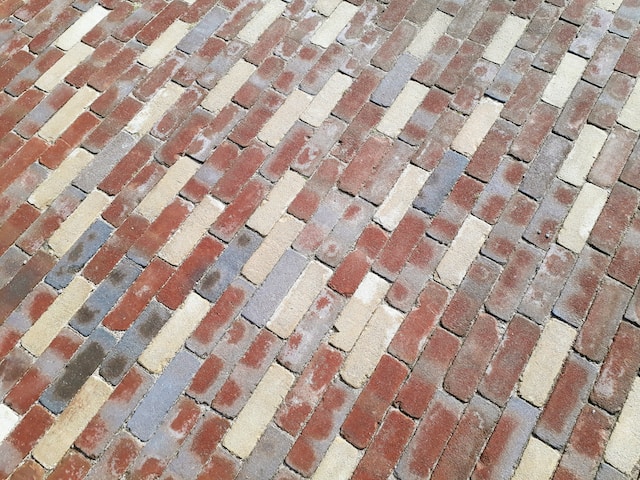Whether made from concrete blocks, brick, or poured concrete, Concrete Contractors Colorado Springs provides functional and aesthetic value to your landscape. However, it is important to understand all the factors involved before you start construction.
First, calculate how many blocks are needed for your retaining wall. This is a critical step that can help you save time and money.

While retaining walls prevent undesired soil movement, they can also add beauty to the landscape. Many styles of concrete retaining walls are designed to mimic the look and feel of stone masonry. But if you want your new retaining wall to hold up to the elements, you’ll need to choose the right material.
One of the most common types of retaining walls is made from poured concrete, which can be molded into various modern designs and last up to 100 years. However, run concrete is extremely heavy and requires highly specialized skills to build. For this reason, it is typically left to professionals.
Another popular choice for retaining walls is block concrete. These specialized blocks are made specifically for building retaining walls and are designed to interlock to create strong and stable structures. Walls built with these blocks can be constructed by homeowners with average DIY skills and a strong back, but anything taller should be left to a professional. A professional will be up to speed on local building codes for retaining walls and have the engineering skills to ensure your retaining wall can withstand any load required to keep.
Concrete is a strong material that resists rot, fire, and rust, making it ideal for retaining walls subjected to various environmental factors, including moisture. It is also easy to work with, allowing contractors to add curves and angles to retaining walls that would be impossible or difficult to construct using other materials. Concrete retaining walls are also less prone to cracking than different types of retaining walls and can be built much more quickly and easily than traditional masonry structures.
While building a retaining wall, planning and including a drainage system in your design is important. Without a proper drainage system, water will accumulate behind the wall and put excessive pressure on it. This pressure can cause the wall to crack or buckle. Weep holes and drain pipes are usually included in the design to help alleviate this problem. Weep holes are lengths of 3/4-inch pipe inserted in the first course of the wall. This allows for water to escape through the gravel that covers them. A plastic drainpipe is placed in the backfill, directing water away from the wall and into the groundwater system.
If you have steep slopes on your property, retaining walls can help control erosion and limit the amount of dirt that shifts during rainfall. In addition, they are an attractive and practical way to add a garden area, patio, or seating area. These structures also help to prevent soil movement and protect against mudslides that can cause injuries on your property.
Many types of retaining wall systems are on the market, including poured concrete, segmental blocks, and precast modular units. Each has its benefits and drawbacks. Some are more expensive than others, but there are ways to cut costs, especially if you do the work yourself.
Poured concrete is the most common type of retaining wall. It’s easy to shape and is durable. However, it’s also costly: You can expect to spend $10 to $100 per square foot for installation and materials. A poured concrete wall can also be stamped or colored and accented with embedded objects to add an artistic element.
The construction of a poured wall is time-consuming and labor-intensive. You’ll need to dig the footings and create a foundation for the wall. You’ll also need to remove any vegetation or topsoil that may get in the way of building your retaining wall, a process called grubbing. This will allow you to lay out your wall and determine the best angle to construct it.
In contrast, a retaining wall built with a block system is less labor-intensive and requires less excavation. Unlike other retaining walls, block retaining walls don’t need to be reinforced with concrete. Instead, they use a layer of gravel or another material to provide a base for the structure.
Segmental blocks, available in various colors, textures, and sizes, are an inexpensive alternative to more expensive retaining wall systems. They require a layer of gravel to backfill, but they do not need a concrete footing, making the construction process quicker.
You can opt for a reinforced soil retaining wall (RSW) for a more cost-effective solution. These structures are strong in compression but weak in tension. , the facing of an SRW wall is reinforced with a high-modulus polymer material known as geogrid.
Concerning concrete retaining walls, you have three main options: building blocks, precast panels, and poured-in-place. Each type has its unique set of advantages, and the choice depends on the specific needs of your project.
Blocks are ideal for retaining walls that support sloped landscapes. They are fireproof, rot-proof, and extremely resistant to freeze-thaw cycles. Plus, they are easily molded to create the shape you need for your project and can be topped with plants, gravel, or other landscaping elements to match the surrounding area.
A block retaining wall is also very easy to build. Start by digging a base of crushed stone or other material that is stable enough to support the height of your wall. Then, lay your first course of blocks, ensuring they are perfectly even from left to right and front to back. Use a carpenter’s level to check and adjust as needed. Continue laying courses evenly spaced with staggered joints until you reach the desired wall height. Be sure to backfill each course with crushed stone for added stability.
Poured-in-place retaining walls are more difficult to construct than their precast counterparts. They require proper construction techniques, which can be challenging in tight spaces and harsh environments. Plus, they do not flex with changes in weather or seismic forces, so they are often not the best choice for projects where the wall will be subject to significant pressures.
On the other hand, precast walls are built in a controlled environment using an assembly line process. This makes them more efficient than a poured-in-place structure because they need not be delivered and erected on-site. Plus, they are made from materials that can be found nearly anywhere, so they reduce the need for lengthy transportation routes that could lead to miscommunication and extended timelines.
Precast concrete retaining walls can also be more easily adapted to the design of your project. They are available in a wide range of styles, finishes, and colors and can be customized to reflect the needs of your organization’s location. In addition, they can be made to resemble other types of materials, such as natural stones, bricks, or timbers, for more design flexibility.
Concrete block walls are durable for many projects, from simple terraces to more complex retaining walls. These blocks are available in various sizes, shapes, and colors to suit any landscape design. They are a popular option for DIYers because they interlock to form a solid wall without needing mortar.
Concrete blocks are also great for retaining walls because they can be easily sculpted to create unique designs. Because of their greater mass, these walls are typically taller than a segmental retaining wall. These walls are ideal for several projects because they can add usable space to a yard, fix drainage issues, and make sloped yards more manageable.
To build a concrete block retaining wall:
- Begin by excavating the soil in the path of your new wall to allow for a solid footing.
- Mark the wall path with a level string line and reference points, such as the corner of your house or an existing landscaping feature on the property. Once the wall’s footing is in place, it is time to lay the first course of blocks.
- Use a hammer and chisel to knock off the flange on the back of the block so it sits flat against the ground.
- Place the block on the foundation and check it with your carpenter’s level to ensure it is even from left to right and front to back.
Continue laying the block courses until your wall has reached the desired height. When you reach the top of your wall, lay the cap blocks on top. These should be slightly angled so that water runs off the retaining wall instead of collecting on it.
If you need a concrete retaining wall that is very decorative, consider using blocks with an ashlar face. These blocks have a rough surface that mimics stone and can be used to add texture and interest to your retaining wall. While you can build a retaining wall from these blocks without mortar, using a pro for any project over 4 feet tall is recommended. This is because a large retaining wall requires a strong footing and rebar for support, and most pros would rather pour that type of wall.
